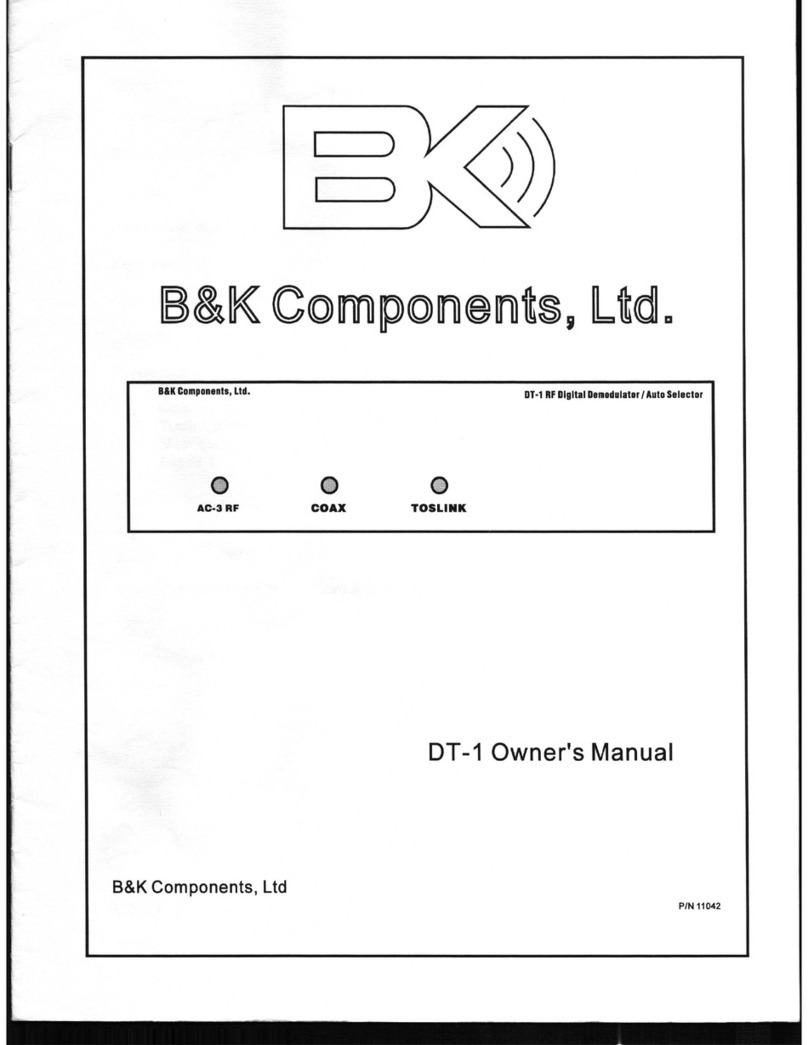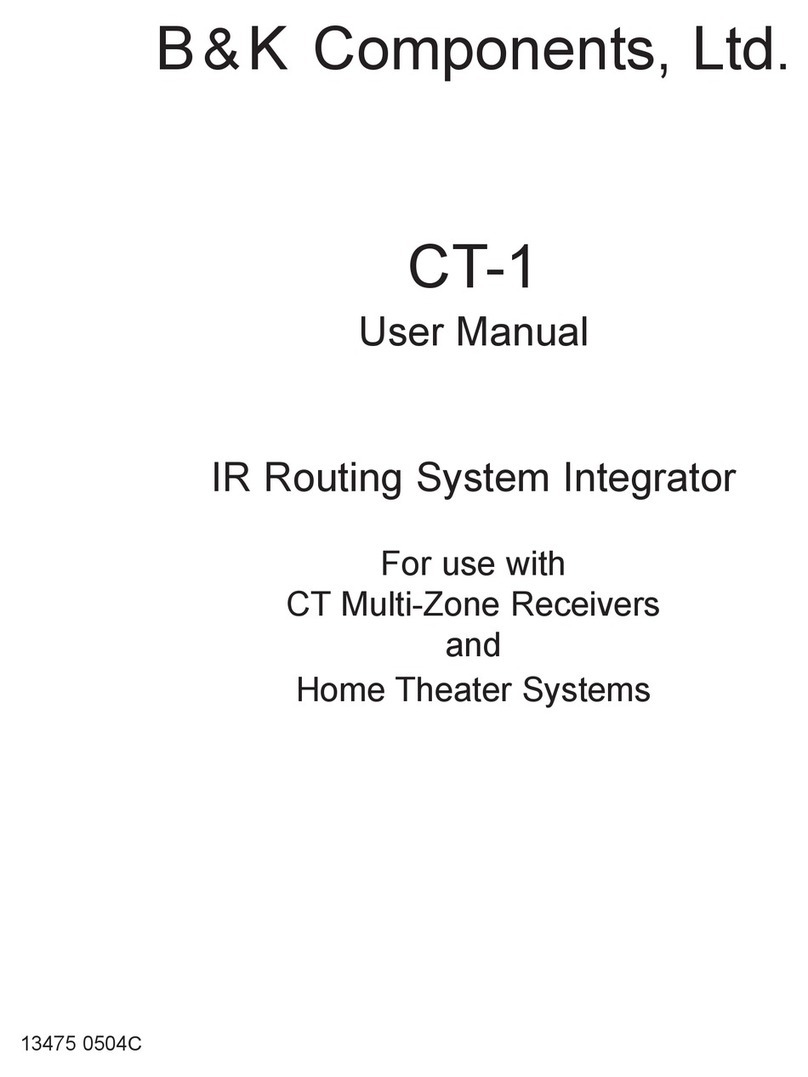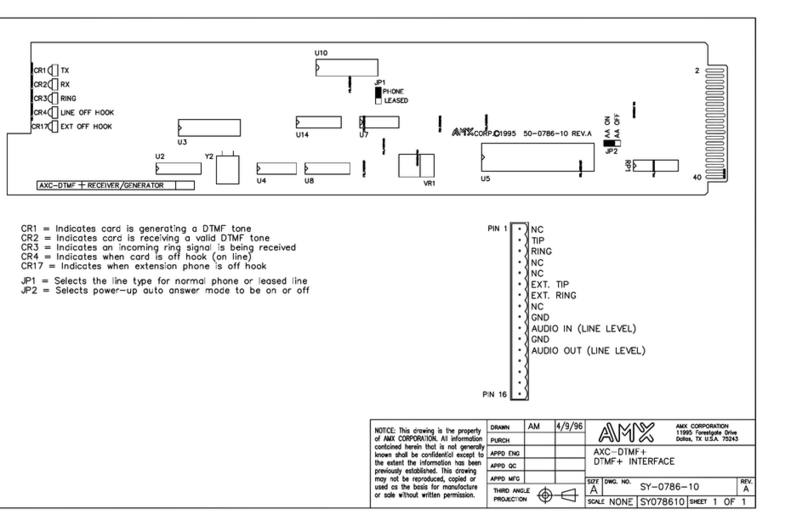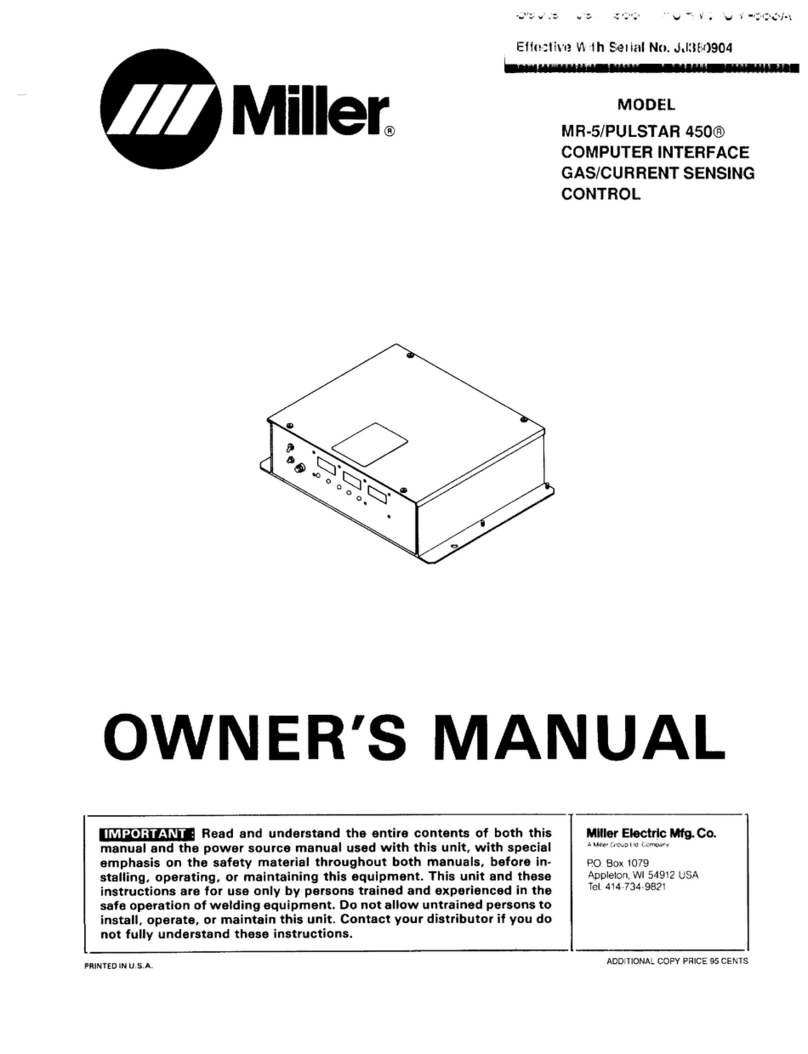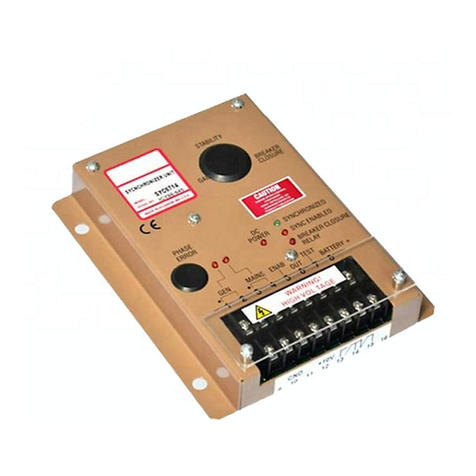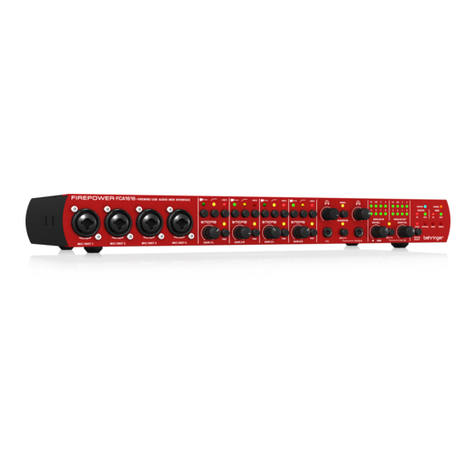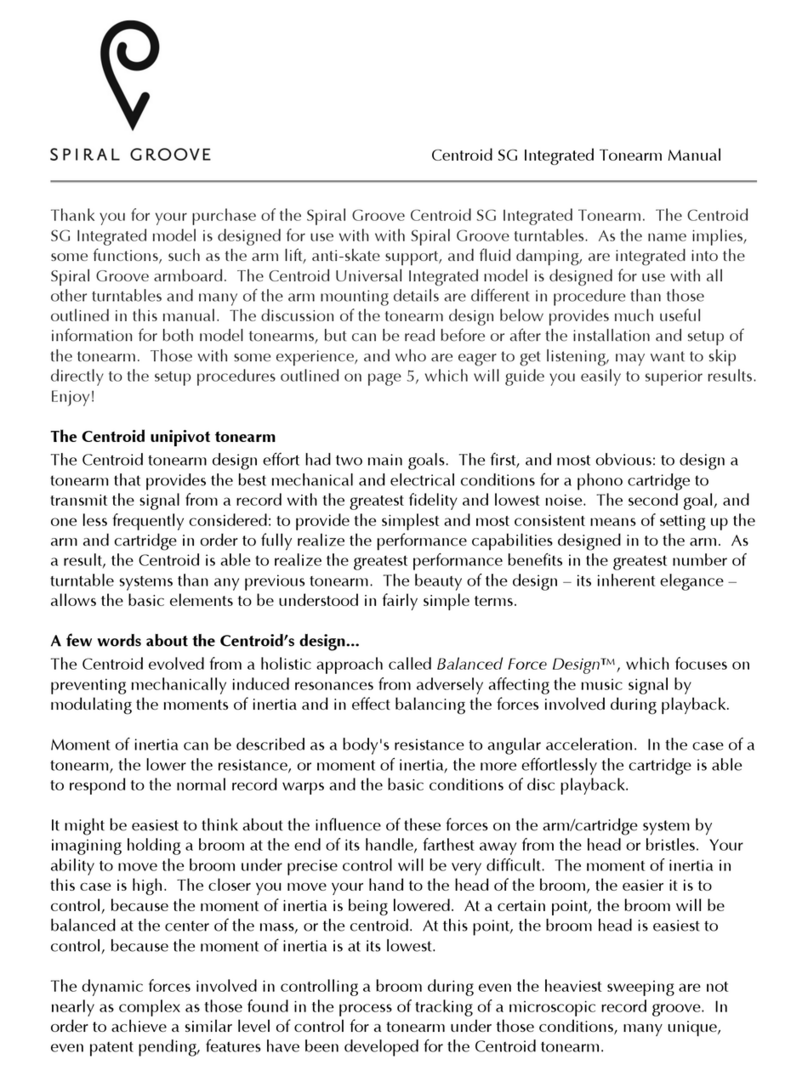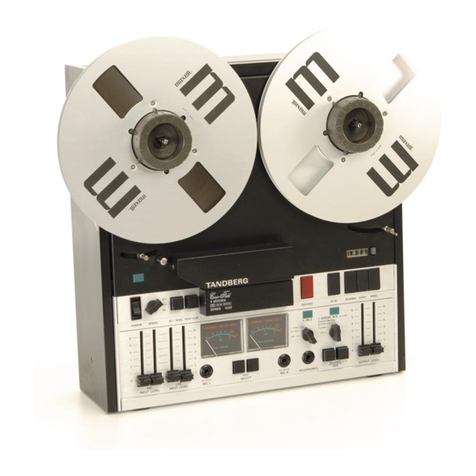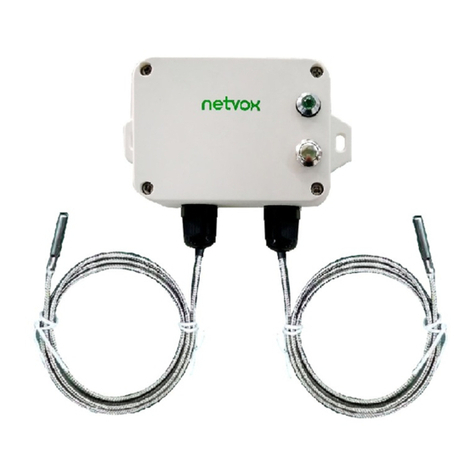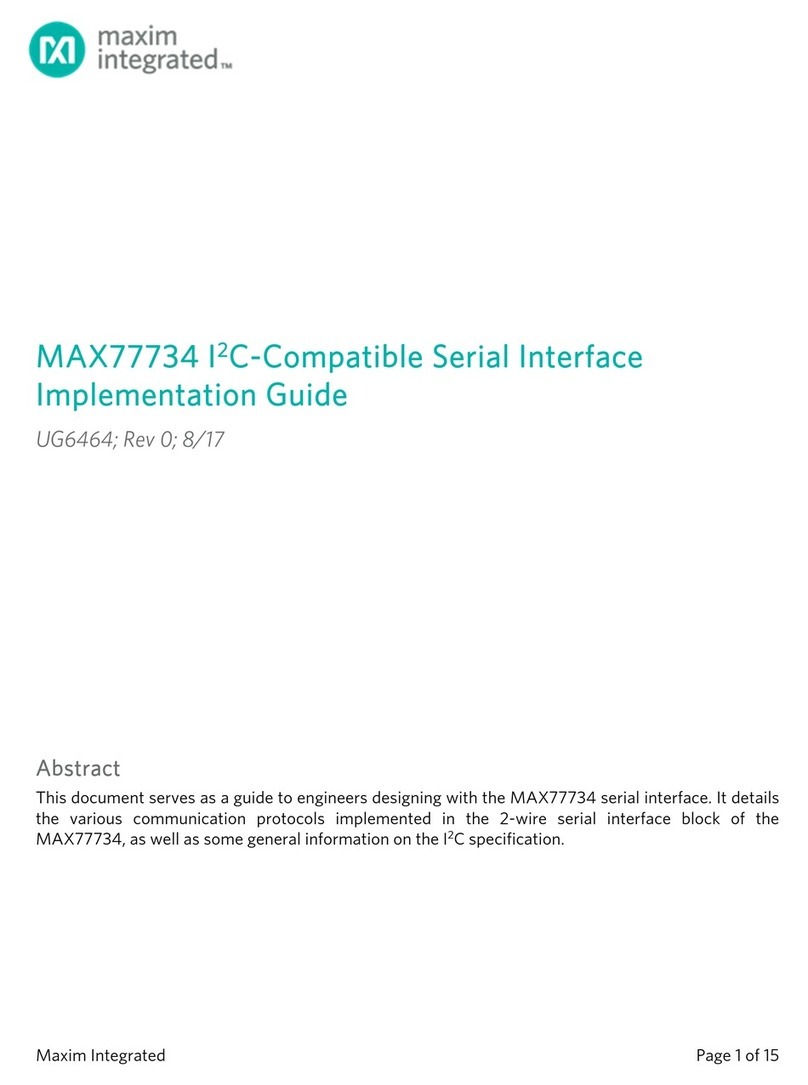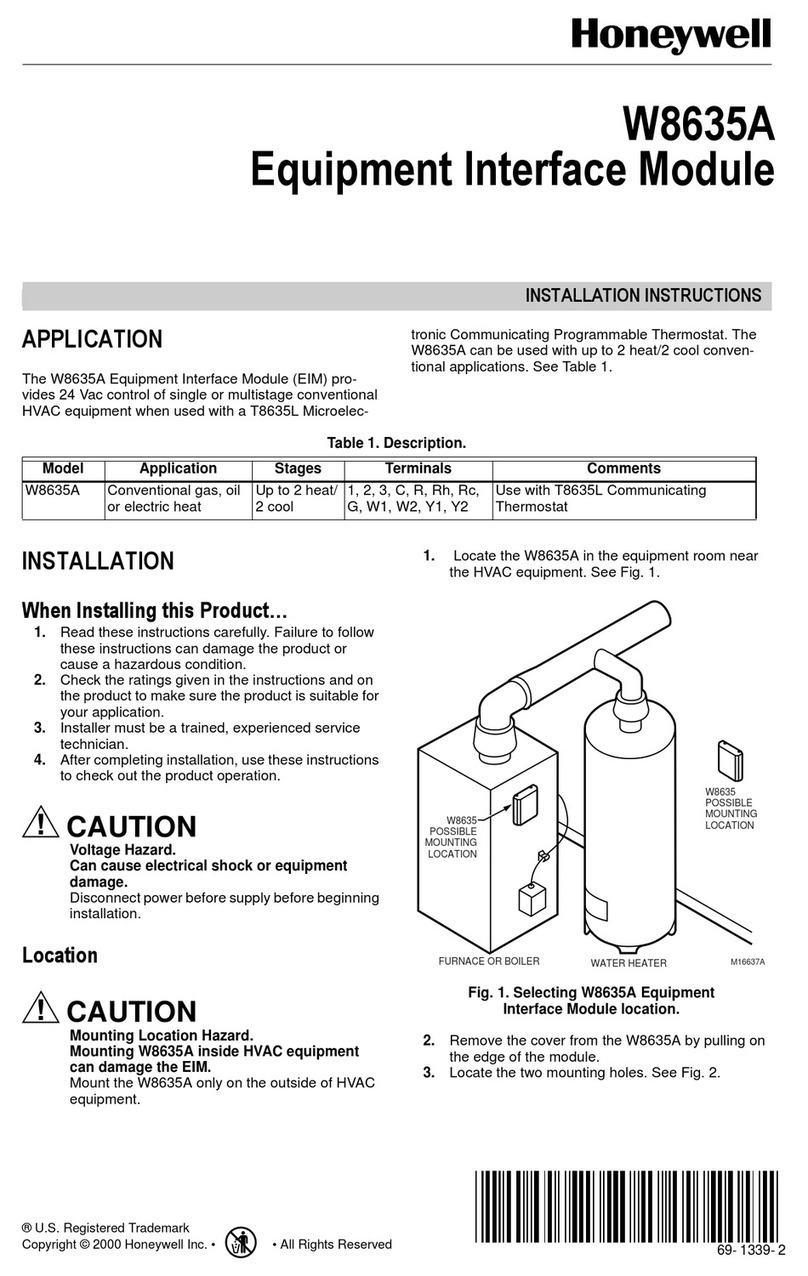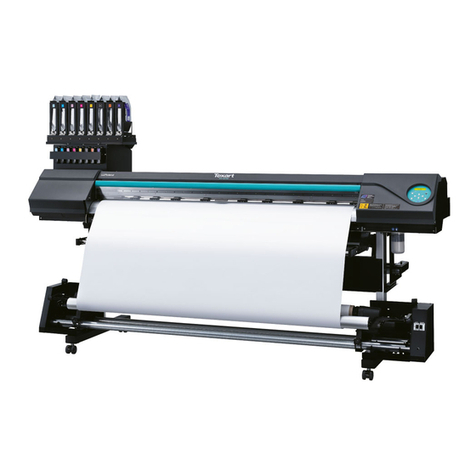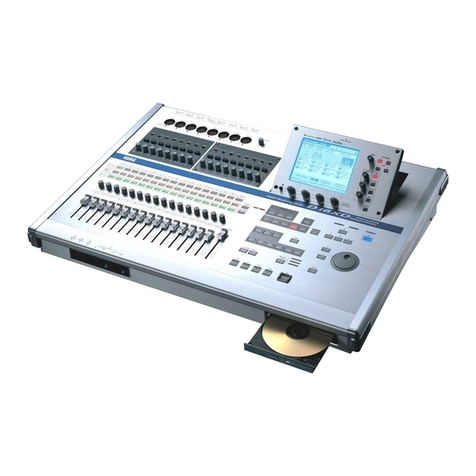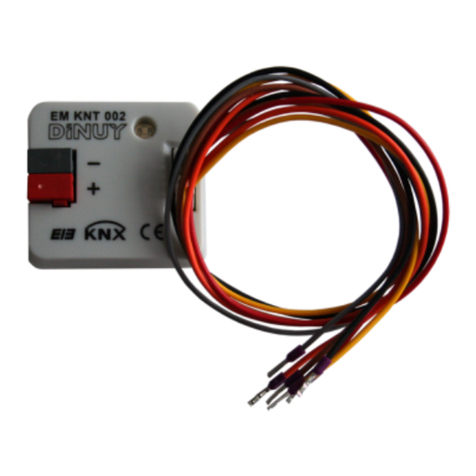B&K 1621 User manual

Instruction
Manual
Tunable Band Pass Filter Type
1621
TuMble B•mt
Pua
Fiher
T~
1821
Overload Power
033-0119
Filter
-20t
Hl
A small
light-weight
portable
filter
with
se-
lectable
bandwidths
of
3%
and
23%
(third
octave), covering
the
frequency range
0,2
Hz
to
20kHz
with
a
continuously
vari-
able
tuned
frequency. Powered
from
inter-
nal batteries
or
an external
DC
voltage.
Suited
for
use
with
B & K Sound Level
Me-
ters
Types
2203,
2209.
2210
and
2218.
B & K
Vibration
Meter
Type
2511.
and the
B & K
Wow
and
Flutter
Meter
Type
6203.
Can be
manually
tuned.
or
tuned
automati-
cally by,
and
synchronously
with,
the
B & K
Portable Graphic Level Recorders Type
2306
and
2309
for
recording spectra from
one
of
the
above
instruments.
+ BrUel &Kjaer


TUNABLE
BAND
PASS
FILTER
TYPE
1621
Applicable
to
instruments
with
serial
numbers
from
6941
24
Revision
September
1981


CONTENTS
1.
INTRODUCTION
AND
SPECIFICATION
(PRODUCT
DATA)
..................................................
.
2.
CONTROLS
..... .....
..
.. .. .... .......... .. .... .......
.........
.. .. .. .... ..........
..
..
.. ..
.......... .... .. ..............
.. ..
........ 3
2.1 . FRONT PANEL ......
.. ..
.......
....
..
.
..
..
.....
..
..
..
..
.........
.. ..
.
..
...
..
....
..
..
...
..
.....
..
.
..
.
..
3
2.2
. REAR PANEL ............. .
..
...
.......
....
.....
............
.
........
.
......
... .......
...............
..
4
3.
OPERATION
..............................................
...................................................................
.......
. 7
3.1 .
MOUNTING
....
.. .. .. ..
...
..
.........
..
..
..
.. ..
..
.....
..
...
.. .. .. ..
..
...
..
.
.. ..
..
.. .. ..
....
..
....
..
..
.. 7
3.2
. POWER SUPPLIES
AND
THEIR USE
.......
......
.......
.. ..
.....
..........
..
..............
..
.. 7
Internal
battery
supply
..
........................................................................... 7
Mains
battery
charger
....................................
..
........................................ 8
Mains
power
supply and
battery
charger Type
ZG
0199
.......................
..
.... 9
Mains
power
supply
Type
2805
................................................................ 9
External
DC
supply
...........................................................................
..
.....
10
3.3.
MANUAL
OPERATION WITH
SOUND
LEVEL
AND
VIBRATION METER
ETC
.....
11
3.
4.
AUTOMATIC
OPERATION WITH LEVEL RECORDERS
TYPES
2306
AND
2309
.
...................................
..
........
.......
..
..
......
........
..
.
12
4.
MEASUREMENT
CONSIDERATION
....................................................................................
.
15
4.1 . FREQUENCY CHARACTERISTICS
.........
.
.....
.
.......
.
.......
......
.. ..
.......
..
......
.......
15
4.2
. PHASE CHARACTERISTICS
......
.
.........
.
..
...
..
..
......
..................
....................
16
4.3.
FILTER SWEEP RATE CONSIDERATIONS
......
..............
......
.
........
..
..............
16
Selection
of
DC
or
AC recording
.................................................................
16
Choosing
the
meter
and recorder settings
....................................................
17
5.
SERVICE
AND
REPAIR
.
.......................................................................................................
20


FEATURES:
•
Tunable
band
pass
frequency
•
Frequency
range
0,2
Hz
to
20kHz
in
5
sub-ranges
•
Selectable
bandwidths
3%
or
23%
(
1/3
Oct.)
•
Two
alternative
input
voltage
ranges
•
Manual
tuning
or
tuned
automatically
from
Level
Recorders
2306
and
2309
•
Internal
battery
or
external
DC
power
supply
•
Small
size and
light
weight
for
ready
portability
USES:
• In
portable
systems
for
narrow
band
frequency
analysis
of
vibration
with
the
General
Purpose
Vibration
Meter
2511
• In
portable
systems
for
narrow
band
frequency
analysis
of
sound
and
vibration
with
the
Sound
Level
Meters
2203, 2209,
2210and
2218
• Recording
frequency
spectrograms
with
one
of
the
above
instruments
plus
the
Portable
Level
Recorders
2306
or
2309
The
Tunable
Band
Pass
Filter
Type 1
621
is
a
variable
frequency
band
pass
filter
intended
for
use as
an
external
filter
with
Bruel
and
Kjrer
measuring
instruments,
to
which
it
gives
the
ability
to
perform
narrow
band
frequency
analysis.
It
is
particularly
suited
for
use
with
the
General
Purpose
Vibration
Me-
ter
2511
for
narrow
band
fre-
quency
analysis
of
vibration,
and
with
the
Sound
Level
Meters
2203
2209,
221
0
and
2218
for
narrow
138-81
type
1
621
Tunable
Band Pass
Filter
Tunable Band Pass
Filter
Type
1621
Overload Power Filter
, Frequency Tuning •
On
12
Frequency Range
20-200
14
2 -
2~
•
0,2 - 2
• -
2k
-2
0k
Hz
Manual
Auto e
Start •• Briiei&Kjaar
band
frequency
analysis
of
sound
and
vibration.
Its
light
weight
and
battery
power
supply
make
the
1
621
the
ideal
portable
instrument
for
applications
away
from
fixed
power
sources.
Description
The
1
621
consists
of
a
tunable
single
pole
butterworth
filter
with
switchable
bandwidths,
its
own
power
supply,
and
the
necessary
control
circuits.
The
FILTER
selector
allows
the
fil-
ter
bandwidth
to
be
switched
to
"3%"
or
to
"23%",
which
are
the
bandwidths
·
between
the
half
power
points,
i.e. 3 dB
down
from
the
peak.
The
selector
also
has a
"Linear"
position,
that
by-passes
the
filter
.
Five
contiguous
frequency
sub-
ranges
can be
selected
from
the
in-
strument's
overall
frequency
range
between
0,2
Hz
and
20kHz,
each
sub-range
covering
one
order
of
magnitude.
The
frequency
may
be
swept
manually
through
the
sub-
range
by
a
large
control
knob
hav-
ing an
attached
pointer
that
sweeps
a scale
showing
the
filter
centre
fre-
quency,
and
the
preferred
centre
fre-
quencies
of
1/ 3 octaves
according
to
ISO R
266
.
Alternatively,
the
Filter 1
621
may
be
tuned
automatically
from
the
Por-
table
Level Recorders
2306
or
2309
when
they
are
interconnected
by a
suitable
cable
(see
specifica-
tions).
The
required
paper speed,
which
controls
the
sweep
rate,
is
F
i
htr!~UI
Medel
In
Oenmartc:
-
Fig
.1.
Rear
view
of
the
Type
1621

set
on
the
level
recorder,
and
the
sweep
is
initiated
from
the
1
621
.
The
filter
is
then
advanced
one
com-
plete decade
synchronously
with
the
recording
paper (QP 01
20,
OP
0124,
QP
0143,
QP
0224,
QP
21
00
and
QP
21
20).
During
this
process,
the
1
621
tuning
knob
does
not
move,
its
position
being
ir-
relevant.
After
one
decade,
the
1
621
frequency
range
is
changed
manually,
and
another
decade is
swept
.
Alternative
input
voltage
ranges
can be
chosen
by a
rear
panel
switch
.
"1
V RM
S"
matches
the
1 V
level
that
the
Vibration
Meter
2
51
1
delivers
to
external
filters
when
op-
erating
in
RMS
mode
.
"0,2
V
RMS"
should
be
selected
for
use
when
the
2
511
operates
in Peak
mode,
or
for
use
with
the
Sound
Level
Me-
ters.
An
"Overload"
lamp
lights
if
these
ranges
are exceeded.
The 1
621
is
powered
by
either
in-
ternal
batteries
or
by
al"l
external
DC
supply
.
The
alkaline
cells
sup-
plied
with
the
instrument
give
about
25
to
30
hours
continuous,
while
rechargeable
NiCd
cells
will
give
16
Frequency
Range:
0,2
Hz
to
20kHz
in 5
sub-ranges
Pass
bandwidth:
Switchable
3%
or
23%
(1/ 3
oct
.)
Attenuation
at
1/ 2
and
2
times
selected
frequency:
Switchable
34
dB
or
16 dB
Dynamic
Range
:
>
40
dB
RMS
with
3%
bandwidth
be-
tween
0,
2Hz
and
6kHz
>
35
dB
RMS
with
3%
bandwidth
be-
tween
6kHz
and
20kHz
>
40dB
RMS
with
23%
bandwidth
be-
tween
0,
2Hz
and
20kHz
Accuracy
of
indicated
frequency:
±
1,5%
at
25
°C,
with
additional
±0 ,
04
%
per
°C
Input:
BNC
socket
1 V
RMS
with
crest
factor
5
0,2
V
RMS
with
crest
factor
5
Input
impedance:
1 V
input:
approx. 1
MO
in
series
with
10pF
0,2
V
input:
approx.
200
kO in
series
with
1
OpF
Output:
BNC
socket
Impedance:
<
0,5
0 in
series
with
100pF
load
Impedance:
;;.
25
kO
to
20
hours
of
continuous
opera-
tion.
A
DC
voltage
can be applied
to
the
1621
to
recharge batteries,
and/
or
to
power
the
instrument.
External
sup-
plies can be
between
+4
and +
15
V,
or
alternatively ±
14
V DC,
which
can
be obtained
from
a
Battery
Charger
ZG
0133,
a
Power
Supply
ZG
0199
or
a car
battery.
When
the
ZG 0
113
or
ZG
0199
is used
the
instrument
can be operated and
the
batteries
re-
charged (at a reduced rate
with
ZG 0
113)
simultaneously.
Portable
Vibration
Analyzer
The
comp.Jetely
self-contained
Por-
table
Vibration
Analyzer
Type
351
3,
shown
in Fig.2,
consists
of
a
Vibra-
tion
Meter
2511A
and a
Filter
1621
installed
in a
rugged
hard-
foam
plastic
Carrying
Case
KA
2000
that
can
contain
1
2/1
2
of
a
19
inch
rack
module
.
Other
items
included
in
addition
to
the
standard
accessories
are
two
connection
cables
AO
0133,
six
rechargeable
NiCd
cells
QB
0008
and
a
Battery
Charger
ZG
011
3
for
the
1621
.
Fig.2
.
Portable
Vibration
Analyzer
Type
3513
Specifications
1
621
Gain
at
se
ected
frequency
:
0
dB±
1
,0
dB
Hum
and
noise:
Max.
Volt
-
age
0.2
Hz - 6 k
1 v
10mV
0.
2V
2mV
Distortion
:
< 1%
3%
Hz
6kHz
-
20kHz
18mV
3.
6mV
Environmental
conditions
:
23
%
0 .2 Hz -
20kHz
10mV
2
mV
The
instrument
performs
within
specifica-
tions
under
the
following
conditions
Operating
temperature:
- 1
0°
to
+
50°C
(
14°
to
122°F)
Humidity:
0
to
90%
relative
humidity
,
non
condensing
Electromagnetic:
Field
strengths
up to
100A
/ m
Power
Consumption:
Typically
200
mA
at
8 V
External
power
supply
:
+ 4 V to + 15 V,
or
± 14 V,
approx
. 2 W
Internal
power
supply:
6 x 1,5 V
cells
(IEC
TypeR
20)
Battery
life
:
25
to
30
hours
continuous
operation
with
alkaline
batteries
(supplied)
16 to
20
hours
continuous
operation
with
NiCd
cells
Charging
time
for
fully
discharged
batter
-
ies
approx
.
14
hours,
12
V
400
mA
Dimensions:
Height:
132,6
mm
(5,2
in)
Width:
139,5
mm
(5,5
in)
Depth:
200
mm
(7,9
in)
(B
& K
module
cabinet
KK
0024
, 4/
12
of
1
9"
rack
module)
Weight:
2,2
kg
(4
,91b)
with
batteries
Accessories
included
:
6
Batteries
QB
0004
7
-pin
DIN
plug
JP
0703
8-pin
DIN
plug
JP
0802
2 BNC
plugs
JP
0035
Accessories
Available
:
Synchronization
cable
for
2306
and
2309
:
AQ
0034
for
2306
from
serial
no
.
718058
and
for
2309
AQ
0182
for
2306
before
serial
no
.
718058
Rechargeable
NiCd
cells
QB
0008
Battery
Charger
ZG
011
3
Power
Supply
ZG
0199

2.1.
FRONT
PANEL
Overload
Overload
In
dicator
--:---JII.,
.
Frequency
Tuning
Knob
Sweep
Control
Sweep
Control
--~-
2.
CONTROLS
Tunable Band
Pass
Filter Type
1621
Frequency Tuning
Power
Filter Power On
·-----------:1---
Indicator
On
1----e
--
Filter
Selector
fJ811'""'cy Range
20-200
14
2-
2~
•
;oo
-2k
0
,2-2
•
Brilel &
K;.t
Frequency
,-----c---
Range Selector
Fig.2.1
.
Front
Panel
of
the
Tunable
Band
Pass
Filter
Type
1621
POWER ON INDICATOR:
This
lamp
lights
when
there
is a
sufficient
voltage
supply
to
the
instru-
ment,
from
internal
and
external
power
supplies.
FILTER SELECTOR:
Note:
It does
not
light
when
the
instrument
is
powered
from
a ±
14
V
DC
source
.
A
4-position
rotary
switch
for
switching
the
instrument
on
and
off,
and
for
selecting
the
required
filters.
"Linear",
"23%",
and
"3%"
are
avail-
able.
In
the
"Off"
pos1t1on,
the
power
is
off,
but
the
input
signal
is
directly
transmitted
to
the
FILTER OUTPUT socket.
In
the
"Linear"
position,
the
output
signal
is
unfiltered,
but
the
input
signal
is also
applied
to
the
23%
bandwidth
filter.
Thus,
when
the
23%
filter
bandwidth
is selected,
there
is
no
"settling
time"
for
the
fil-
ter;
the
filtered
signal
is
instantly
available.
3

FREQUENCY RANGE
SELECTOR:
FREQUENCY
TUNING
KNOB:
OVERLOAD INDICATOR:
SWEEP CONTROL:
SWEEP CONTROL INDICATOR:
THUMBWHEEL:
2.2.
REAR '
PANEL
FILTER
INPUT:
FILTER
OUTPUT:
4
A
5-position
rotary
switch
for
selecting
the
decade
required
for
analysis.
Two
scales
are
shown,
the
upper
scale
giving
the
decade
for
selection
and
the
lower
scale
giving
the
factor
by
which
the
scales
on
the
FREQUENCY
TUNING
KNOB
should
be
multiplied
to
give
the
actual
frequency
or
RPM
value.
A
continuously
variable
tuner
covering
a
range
of
one
decade
select-
ed
by
the
FREQUENCY RANGE SELECTOR.
The
outer
scale
shows
the
centre
frequency
of
the
band
being
swept
and
the
inner
scale
shows
the
RPM
value.
To
obtain
the
actual
frequency
or
RPM
value
the
scale
values
should
be
multiplied
by
the
factors
given
on
the
lower
scale
of
the
FREQUENCY RANGE SELECTOR.
The
small
black
circular
marks
in
between the
scales
indicate
the
prefered
centre
frequencies
of
the
1I 3
octave
bands
according
to
ISO
R
266.
The
FREQUENCY
TUNING
KNOB
has
no
effect
when
the
SWEEP
CONTROL
switch
is
set
to
Auto.
This
lamp
lights
whenever
too large a voltage is applied
to
the
FILTER
INPUT socket; depends on
the
setting
of
the
VOLTAGE RANGE SELEC-
TOR
on
the
rear panel.
A
3-position
paddle
switch
to
select
the
method
of
tuning
the
filter,
with
positions as
follows:
"Manual":
In
this
upper
position,
the
filter
is
tuned
manually
by
the
FREQUENCY TUNING KNOB.
"Auto":
In
this
central
position
the
filter
is
tuned
automatically
from
the
Portable Level Recorder· Type
2306
or
2309
when
a
suitable
cable connects
the
two
instruments.
The
sweep
will
always
start
at
0,2
Hz (or a decade
multiple
thereof)
and
will
sweep
one decade.
"Start":
When
the
switch
is depressed
to
this
spring-loaded
self
re-
turning
position and released (so
that
it
comes back
to
"Auto"),
the
Por-
table Level Recorder Type
2306
or
2309
will
start,
when
the
rele-
vant
cable connects
the
1
621
and
the
appropriate recorder and
will
sweep
the
filter
synchronously
with
the
recording paper over one
com-
plete decade (selected by
the
FREQUENCY RANGE SELECTOR) and
then
stop.
During
this
process,
the
position
of
the
FREQUENCY TUN-
ING KNOB is
irrelevant,
and
it
does
not
move.
This
lamp
lights
when
the
filter
is
actually
being
swept
synchronously
by
the
Portable Level Recorder Type
2306
or
2309.
At
the
end
of
de-
cade,
when
the
sweep
stops,
the
lamp goes
out.
The
knurled
knob at
the
bottom
centre
of
the
front
panel is
to
release
the
baseplate
to
enable
the
1
621
to
be
mounted
in
a rack or portable
carrying
case.
Turn
it
anticlockwise
to
release,
clockwise
to
tighten.
A BNC socket
for
feeding
the
signal
into
the
instrument.
A BNC socket
for
feeding
the
filtered
signal
out
of
the
instrument.

In
put
Voltage
Se
lector
Power Selector
FiIter Output
G
ro
un
ding Po
in
t
Fig.2
.2.
POWER SELECTOR:
INPUT VOLTAGE SELECTOR:
EXTERNAL POWER SUPPLY:
External Power
Charge Input
+ 15 V
DC
Battery Cover
Release Screw
External
Power Supp
ly
Filter
In
put
Synchronization
Rear
Panel
of
the
Tunable
Band
Pass
Filter
Type
1621
A
2-position
slide
switch
for
selecting
internal
or
external
power
sup-
ply.
A
2-position
slide
switch
for
selecting
the
maximum
input
voltage.
"0,2
V
RMS"
and "1 V
RMS"
are available.
A
7-pin
DIN socket
for
accepting an external
DC
power
supply voltage
for
powering
the
instrument
and
for
recharging
its
internal
cells. The
pin
connections
are
shown
in
Fig.2.3.
See also section
3.2
.
&
WARNING!
Never apply a charge voltage to
alkaline
or
conventional
dry
cells:
there
is a
danger
of
explosion.
External Power
---+-------
-
--Drive
Input
Dual Polari
ty
External Power
Drive Input
+ 4
to
+ 15 V
DC
7
90
77
4
Fig.2.3.
Pin
Connections
of
EXT. POWER SUPPLY Socket.
External
view
5

SYNCHRONIZATION:
BATIERY COVER RELEASE
SCREW:
6
An
8-pin
DIN socket
to
enable
the
filter
frequency
to
be
swept
by
the
Portable Level Recorder Type
2306
or
2309
synchronously
with
its
re-
cording paper. For
details
of
connections,
synchronization,
sweep
rate,
and
operation
, see section
3.4.
This
retained
screw
enables
the
top plate
of
the
instrument
to
be
rem-
oved
for
battery
replacement.

3.1.
MOUNTING
3.
OPERATION
The
1
621
can
be used
free
standing
on
its
four
feet
or,
to
enable
better
viewing,
the
front
may
be
raised
using
the
metal
stand
attached
to
the
underside
of
the
instrument
.
For easy
transportation
the
1
621
can
be
fitted
into
a
hard
foam
plastic
carrying
case
Type
KA
2000,
capable
of
carrying
three
instruments
the
size
of
the
1621.
3.2.
POWER
SUPPLIES
AND
THEIR
USE
There
are
several
methods
of
supplying
power
to
the
1
621
.
Although
it
is
primarily
a
small
lightweight
portable
Filter
which
is
powered
by
its
own
internal
batteries,
it
may
also
be
driven
-
from
an
external
power
supply.
The
choice
of
power
supply
depends
on
whether
it
has
to
be
capable
of
recharging
the
internal
cells
of
the
Filter,
and
also
whether
it
has
to
power
other
instruments
in
the
measurement
chain
at
the
same
time.
The
various
possibilities
are
outlined
in
the
following
sections.
3.2.1.
Internal Battery Supply
Six
1,5
V
alkaline
dry
cells
(conforming
to
IEC R
20)
are
supplied
with
the
1621,
with
a
battery
life
of
25
to
30
hours
continuous
operation
(8
& K
stock
No. QB
0004).
Other
1,5V
standard
dry
cells
may
also be
used,
these
however,
will
only
have
a
battery
life
of
approximately
6
to
8
hours.
150516
Fig.3.1.
Position
of
Cells
in
Battery
Compartment
of
1621
7

The 1
621
may
also be
powered
using
six rechargeable
nickel-cadmium
batteries
(B
&K
Stock No. QB
0008),
which
can be supplied as accessories. The cells
recommended
are
SAFT VOLTA BLOCK Type
VR
40
which
have a voltage and charge
rating
of
1,2
V and 4
amp.
hours
respectively.
(Any
rechargeable cell
with
equivalent
ratings
may
be used,
however). SAFT,
the
cell
manufacturers
specify
that
with
normal
use
the
cells have a
minimum
of
500
charge
cycles before
replacement
is necessary. The need
for
replace-
ment
is indicated by
the
cells
failing
to
reach a
fully
charged
condition
after
having
been
on charge
for
14
hours
or
more. The
battery
life
will
be
between
16
ar:'ld
20
hours
con-
tinuous
operation.
&
WARNING!
Never
attempt
to
recharge
alkaline
or
conventional
dry
cells
·
or
batteries
with
poles reversed:
there
is a
danger
of
explosion.
Similarly
never
mix
different
types
of
battery,
or
batteries
that
have been used in
other
instruments
or
battery
packs.
This
can
cause
internal
reversal
of
battery
polarity.
The cells
may
be
fitted
as
follows:
1. Loosen
the
battery
cover release
screw
(see
Fig.2.2)
and.slide
the
top plate
of
the
in-
strument
off
towards
the
rear. (The
screw
is captive, so
it
cannot
be lost).
2. Place
the
cells in
the
compartments
with
the
polarities
indicated. (See Fig.3.1
).
3. Replace
the
top panel.
4.
Select
"Internal
Battery"
witt"l
the
POWER SELECTOR
switch
on
the
rear
of
the
1621.
5. Select
"Linear"
with
·
the
FILTER SELECTOR, and check
that
POWER INDICATOR
lamp is
lit
to
ensure
the
batteries have
sufficient
power.
6.
Switch
the
1
621
off
after
the
battery
check.
7. Label
the
instrument,
stating
which
type
of
cells have been
installed.
If
alkaline
or
standard
dry
cells have been
fitted,
then
also
include
the
warning
"EXPLOSION
RISK -NOT TO
BE
RECHARGED".
3.2.2.
Battery
Charger
ZG
0113
8
A
Battery
Charger
ZG
0113
(Fig.3.2)
is available as an ·accessory
on
separate
order
for
recharging
the
cells QB
0008,
the
recharge
time
being approx.
14
hours
for
fully
dis-
charged cells. The
charger
is
merely
plugged
into
the
mains
supply, and
connected
to
the
EXTERNAL POWER SUPPLY socket
of
the
1
621
. Colour coding
of
the
connections
for
the
different
mains
voltages is:
Blue
0 V (Neutral)
Black
100-
130V
AC
Brown
200
-
240
V AC
&
WARNING!
Clip back and
insulate
the
line
not
in
use.
The
charger
may also be used
to
power
the
instrument
at
the
same
time
as
recharging
the
cells. In
this
situation,
however,
the
battery
recharge
time
will
be
longer.

ffi
WARNING!
Never
apply
a
charging
voltage
to
the
1621
when
non-rechargeable
cells
are
fitted
:
There
is a
danger
of
explosion.
Fig
.3 .2.
ZG
0113
Battery
Charger
3.2.3.
Mains
Power
Supply
and
Battery
Charger
Type
ZG
0199
The
Power
Supply
Type
ZG
0199
is
capable
of
providing
a
driving
voltage
of
+
7,5
V
DC
and
a charging
voltage
of
+
12
V
DC
simultaneously
or
separately,
controlled
by
a
switch
on its
front
panel. One
instrument
may
be charged while
three
(e.g. a
1621,
a
2511
Vibration
Meter,
and a
2306
I
2309
Level Recorder)
may
be
powered
simultaneously
from
the
ZG
0199.
The
output
socket
of
the ZG
0199
is
connected
to
the
EXTERNAL POWER
SUPPLY
socket
of
the
1621
with
the
connections
shown
in
Fig.3.3.
Cable
AQ
0035
(available as an
accessory
on serarate order) is suitable
for
this
connection
even
though
all 7
of
its
pins are
connected
1
to
1, 2
to
2 etc.; there is
no
need
to
disconnect
pins 4
to
7.
For
powering
the
other
instruments
from
a ZG
0199,
consult
their
Instruction
Manuals. Provided
the
total
combined
drive
current
does
not
exceed 1
,25
A,
the
ZG
0199
is a
very
useful
power
supply.
With
such a
set-up,
however,
a
ground
loop
is
formed
by
the
0 V line
of
the
power
supply
and
the
sreening
of
the signal cables.
This
may
prove
troublesome
when
measuring small
vibration
levels, and in
this
case
it
is
recommended
that
the
screening be
dis-
connected
from
the
plug
at
one end
of
each
of
the signal cables.
Power Supply
ZG 0199
Output S
ocket
+7,5 V DC
ov
JP
0703
+12 V DC
Ch
arge
+12 V DC
ov
JP
0703
Driv
e
+7,5 V DC 1621
Exte
rn
al Power
Supply
S
ocke
t
750449
/ 1
Fig. 3.3 .
Connections
for
external
power
to,
and
for
recharging
inter-
nal
batteries
of,
1621
.
External
view
of
sockets,
soldering
side
of
plugs
shown
3.2.4.
Mains
Power
Supply
Type
2805
The
Power
Supply
Type
2805
contains
two
channels,
each
of
which
can
supply
either
+28
V DC
or
±14
V
DC
.
When
either
channel
is
switched
to
±14
V
it
is
suitable
for
pow-
ering
the
1
621,
but
not
for
charging
the
internal
cells
as
its
current
rating
is
not
suffic-
iently
high.
Connection
of
the
Bulgin
socket on
the
rear
panel
of
the
2805
to
the
EXTER-
NAL
POWER SUPPLY
socket
on
the
1621
is
shown
in
Fig.
3.4.
Ensure
that
the
CHAN-
NEL 1
switch
on
the
front
of
the
2805
is set
to
"±14
V",
i.e.
the
switch
should
be up. (If
channel
2 is
used,
then
pins
4,
5, 6
of
the
2805
socket
should
be
used
instead
of
pins
9

2805
Output
Socket
JP 4705 JP
0703
750448
Fig.3.4.
Connections
from
the
2805
to
the
1621
for
power
supply.
External
view
of
sockets,
soldering
side
of
plugs
shown
3,
2,
1 respectively,
and
the
CHANNEL
2
switch
should
be
set
to
"±14
V".)
One
instru-
ment
may
be
powered
from
each
channel.
Any
other
±14
V
DC
source
should
be
connected
to
the
same
three
pins
on
the
1
621,
i.e.
-14V,
OV and
+14'1
DC.
All
three
pins
must
be
connected.
Note:
The
POWER ON INDICATOR does
not
light
when
the
instrument
is
powered
from
a
±14
V DC source.
3.2.5.
External
DC
Supply,
4
to
15
V
10
A
car
battery,
or
other
DC
source
of
between
4 V and
15
V
with
a
capacity
of
2 W
or
more,
may
be used
to
power
the
1
621.
The
source
is
applied
to
the
1621
via
the
EXTER-
NAL
POWER SUPPLY socket on
its
rear
panel as
shown
in
Fig.3.5.
4
to
15 V
DC
ov
JP 0703
+4
to
+15
V
DC
1621
External Power
Supply Socket
750446
/1
Fig.3.5
.
Connections
for
external
DC
source
connection
to
1621.
External
view
of
socket,
soldering
side
of
plug
shown
If
recharging
or
powering
of
the
1
621
is
carried
out
in
a
car
that
has
a
positive
-
earth
system,
and
the
car's
own
battery
is
being
used,
then
the
1621
should
be
isolated
from
the
car's
chassis and bodywork. The
rest
of
the
instrumentation
chain
should
also be
sui-
tably
isolated
from
the
car, since
the
signal
cables
are
connected
to
a
common
ground.
This
is
important
since
the
metal case
of
the
1
621
and
of
other
connected
instruments
will
have
a
potential
12 V
below
that
of
the
car
chassis/body
when
connected
to
the
battery,
and
the
battery
could be
short-circuited
if
the
instruments
are
allowed
to
touch
the
car
chassis/body.
If
it
is
impossible
to
isolate
the
instruments
effectively
the
battery
should
be
disconnected
from
the
car's
chassis.
For
simultaneous
powering
of
the
1
621
and
charging
of
its
internal
cells,
a 15 V DC
source
may
be
connected
to
the
EXTERNAL POWER SUPPLY socket
of
the
i
621
as
shown
in
Fig.3.6.
If
charging
only
is
required
then
pin
1
need
not
be
connected.

15 V
DC
+15
V
DC
ov
JP
0703
1621
External Power
Supply Socket
750447
/ 1
Fig.3.6.
Connections
for
simultaneous
operation,
and
charging
cells,
of
1621.
External
view
of
socket,
soldering
side
of
plug
shown
3.3.
MANUAL
OPERATION
WITH
SOUND
LEVEL
AND
VIBRATION
METER
ETC
To
Ext.
Filter
Vibration
Meter
2511
The 1
621
is
ideally
suited
for
use as an external
filter
to
portable
instruments
such
as a
Vibration
Meter
or
a
Sound
Level
Meter.
Fig.3.7
shows
some
examples
of
how
the
instruments
may
be
set
up.
Sound Level
Meters
2203/2209
2210/2218
In Out
To
Ext.
Filter
·~
·
~In_....,....,
. --
;_
·-_
.-
Out
-,
.....
..
Flutter
Meter
6203
Level
Recorder
2306
~
-
-
,·
·~
1-------S..;..y_nc_hr_o_nisa_t_io_n
___________
__,
·.
-~~-------------------------,
Tunable
Band
Pass
Filter
1621 Level
Recorder
2309
AO
0182 (For 2306
with
serial N° below
718058)
AO
0034 (For 2306
with
A00034
serial N° above
718058)
790775
Fig.3.
7.
Combination
of
the
1621,
Tunable
Band
Pass
filter,
with
Sound,
Vibration
and
Flutter
meters
The 162 1 is used as
follows:
1.
Select
"Internal
Battery"
or
"External
Power"
as
required.
See
Section
3.2.
2.
Using
the
INPUT VOLTAGE SELECTOR, select
the
maximum
input
voltage
range
to
be used. The
actual
noise level is
lower
in
the
"0,2
V
RMS"
position,
so
this
should
be used
whenever
a
small
signal is
to
be
filtered.
With
the
2511
set
to
"RMS",
the
1
621
should
be
set
to
"1
V
RMS".
With
the
2511
set
to
"Peak
-
to
Peak",
or
with
instruments
2203,
2209,
2210,
2218
or
6203,
the
1621
should
be set
to
"0,2
V
RMS".
11

3.
Use
the
FILTER SELECTOR knob
to
choose
the
required
analysis
bandwidth.
The
POWER ON
lamp
should
light
-
if
not,
check
the
power
supply.
(Remember,
how-
ever,
that
the
lamp
does
not
light
for
a ±
14
V DC source).
4.
Select
EXT. FILTER
on
the
Sound
Level
Meter
or
Vibration
Meter
in
use
and
apply
a
signal
to
the
1
621
.
5.
Set
the
SWEEP CONTROL
switch
to
"Manual".
6.
Using
the
FREQUENCY RANGE SELECTOR,
choose
the
first
decade
of
interest
for
an-
alysis.
7.
Using
the
FREQUENCY TUNING KNOB,
select
the
frequencies
of
interest,
and
note
the
Meter
reading and
the
frequency.
8.
If
the
OVERLOAD
indicator
lamp
lights,
the
signal
input
to
the
Filter
is
too
large
-
either
adjust
the
signal
input
amplitude
or
change
the
INPUT VOLTAGE SELECTOR
from
"0,2
V
RMS"
to
"1
V
RMS"
as
appropriate.
9.
Repeat 6
and
7 as necessary.
If
the
frequencies
of
interest
are
not
known,
the
FREQUENCY TUNING KNOB
may
be
turned
slowly
across
the
complete
range
in
the
"23%"
position
(changing
the
FRE-
QUENCY RANGE SELECTOR as necessary)
until
high
levels
are
indicated
on
the
Meter.
These
levels and
frequencies
should
be
noted,
and
then
a 3%
bandwidth
analysis
can be
made
later
if
necessary
to
give
improved
resolution
around
those
frequencies.
3.4.
AUTOMATIC
OPERATION
WITH LEVEL
RECORDERS
TYPE
2306
OR
2309
12
It
is
often
a
great
advantage
if
a
hard
copy
of
a
spectrum
can
be
plotted
out
while
the
an-
alysis
is proceeding. The 1621 has been
designed
for
use
in
conjunction
with
Portable
Level Recorders Type
2306
or
2309
for
that
purpose.
When
the
1
621
and
2306/2309
are
connected
together
with
the
appropriate
cable,
and
the
.
1621's
SWEEP CONTROL
switch
is set
to
"Auto",
the
2306/2309
will
sweep
the
filter
synchronously
with
its
re-
cording
paper as soon as
the
"Start"
button
has
been depressed.
The
synchronization
cable
to
be used depends upon
the
type
of
Level Recorder
being
used. For
those
with
a
8-pin
DIN socket, i.e. a
2306
with
a
serial
number
718058
or
higher
and
all
2309's,
then
a cable
AQ
0034
should be used
with
the
pins
connected
1-1,
2-2,
...
8-8.
For a
2306
before
number
718058,
which
had a
7-pin
DIN socket
for
synchronization,
cable
AQ
0182
should
be used. (see
Fig.3.8
for
pin
connections).
2306
Remote
Control Socket
JP
0703
JP
0802
1621
Sync.
Socket
770776
Fig
.
3.8.
Cable
AQ
0182
for
frequency
synchronization
between
1621
Filter
and
2306
Level
Recorder
(before
serial
no.
718058).
External
view
of
sockets,
soldering
side
of
plugs,
shown

The
procedure
for
using
the
1
621
and
2306/2309
combination
is
as
follows:
1.
Connect
the
1621
and
2306/2309
into
the
instrumentation
line
as
required
(see
also
section
3.
3)
with
the
1621
connected
to
the
Level Recorder
by
cable
AQ
0034
or
AQ
0182
as
required.
2.
On
the
1621
select
"Internal
Battery"
or
"External
Power"
as
required.
See
section
3.2.
3.
Using
the
INPUT VOLTAGE SELECTOR, select
the
maximum
input
voltage
to
be
used.
4.
Use
the
FILTER SELECTOR knob
to
choose
the
required
analysis
bandwidth.
5.
Set
the
SWEEP CONTROL
switch
to
"Auto".
6. Check
that
the
batteries
are
fully
charged
in
the
appropriate
Level Recorder
and
fit
the
correct
paper. For
the
2306
frequency
calibrated
paper
Type QP
0120,
QP
0124,
QP
0143
or QP
0224
should
be used and
for
the
2309
Type QP
2100
or
QP
2120
.
Set
on
the
2306:
PAPER DRIVE
POWER
PEN
DRIVE
or
on
the
2309:
PAPER
PEN
PAPER DRIVE
POWER
"In"
"On"
"In"
''Forward''
"Down"
"Cont
."
"On"
7.
Calibrate
the
pen
deflection
of
the
recorder (see
the
2306
or
2309
Instruction
Man-
ual).
8.
Using
the
FREQUENCY RANGE SELECTOR
of
the
1621
choose
the
first
decade
of
in-
terest
for
analysis.
9.
Adjust
the
position
of
the
recording paper
until
the
pen
lies
directly
over
the
begin-
ning
of
the
frequency
decade
to
be
swept.
(The
position
of
the
FREQUENCY TUNING
KNOB
of
the
1
621
is
irrelevant
when
tuning
is
controlled
by
the
2306/2309,
and
it does
not
move
during
the
sweep.
1
0.
Select
the
required
recording
paper speed,
bearing
in
mind
that
this
will
control
the
filter
sweep
speed (see section
4.3).
11
.
Select
the
required
writing
speed,
bearing
in
mind
that
this
will
also
affect
the
aver-
aging
time
(see
section
4.3).
If
DC
recording is
being
used,
averaging
time
must
be
set
on
the
meter
to
which
the
1
621
is
connected.
12. Depress
the
1
621
SWEEP CONTROL
switch
to
"Start"
and
release
it
to
the
"Auto"
position.
The
2306/2309
will
now
sweep
the
filter
synchronously
with
its
record-
ing paper
over
one
decade
from
"2"
to
"20"
on
the
1
621
scale
(without
the
pointer
moving
whilst
this
happens). The SWEEP CONTROL INDICATOR
lamp
of
the
1621
13

14
will
light
during
the
sweep.
When
the
decade has been
swept,
the
Level Recorder
and
the
filter
sweep
will
stop
and
the
SWEEP CONTROL INDICATOR
lamp
will
go
out.
13. Repeat steps 8 - 13 as
necessary
for
the
next
decades
of
interest.
Synchronization
will
be
maintained
during
the
process, and
from
one
chart
to
the
next.
I
Table of contents
Other B&K Recording Equipment manuals
